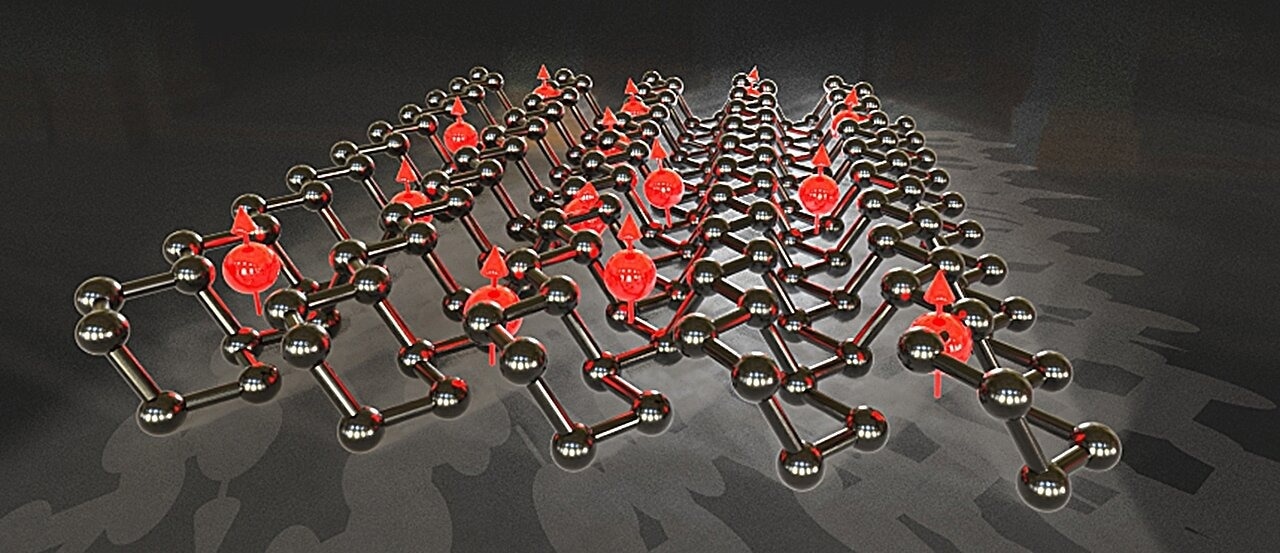Researchers report the highly anisotropic spin transport nature of two-dimensional black phosphorus, a significant achievement in the field of spintronics. The study, published in Nature Materials was led by Professor Barbaros Özyilmaz and Assistant Professor Ahmet Avsar, both affiliated with the Department of Physics and the Department of Materials Science and Engineering at the National University of Singapore (NUS).
 The schematic illustrates the crystal structure of monolayer black phosphorus, with spins oriented in the favorable out-of-plane direction. Image Credit: Alberto Ciarrocchi and Ahmet Avsar
The schematic illustrates the crystal structure of monolayer black phosphorus, with spins oriented in the favorable out-of-plane direction. Image Credit: Alberto Ciarrocchi and Ahmet Avsar
It is necessary to investigate alternative technologies outside of traditional electronics since current electronic devices are getting close to the limitations of Moore’s law and because integrated circuit design continues to face power dissipation challenges. One such strategy that could address these problems and provide hope for the development of lower-power devices is spintronics.
Unlike the typical electronic device movement of charge, spintronics focuses on novel devices that manage the fundamental electron feature called “spin.” Spin imparts to electrons a rotational character analogous to charges around an axis, causing them to act like miniature magnets with magnitude and direction.
There are two possible states for the electron spin, called spin “up” and spin “down.” Clockwise and anticlockwise rotations are comparable to this.
Spintronics functions by modifying the electron spin, whereas conventional electrical devices move charges around the circuit. This is significant because, in contrast to the motion of spin, which inherently dissipates less heat, moving electrical charges across conventional electric circuits inevitably results in some power being wasted as heat. This feature could make it possible for devices to operate at lower power levels.
The features of spin “channels,” essentially wires that may help move spins around, are of special interest to researchers working with materials at the atomically thin limit.
Choosing the right material is paramount in spintronics. Highly performant and functional spin channel materials are the backbone of spintronics devices, allowing us to manipulate and control spins for diverse applications.
Barbaros Özyilmaz, Professor, Department of Physics, National University of Singapore
One such newly discovered material that is gaining interest is black phosphorus because of its advantageous spintronics characteristics. Due to the peculiar puckered crystal structure of black phosphorus, the orientation of its spins also affects how they behave.
Black phosphorus showcases highly anisotropic spin transport, deviating from the normal isotropic behavior seen in conventional spin channel materials. Its crystal structure imparts directional characteristics to spin transport, offering new possibilities for controlling spintronics devices.
Ahmet Avsar, Assistant Professor, Department of Materials Science, National University of Singapore
The scientists created ultrathin spin valves made of black phosphorus that are sandwiched between layers of hexagon-shaped boron nitride. By introducing spins into the black phosphorus at one end of the apparatus and adjusting the spin current’s direction at the other, the spin signal was measured to investigate the spin transport anisotropy.
A strong magnetic field perpendicular to the black phosphorus layer was applied during the measurements, and the results were compared to those obtained with a mild magnetic field.
The spin signal increased significantly when a high magnetic field was applied, the researchers discovered. The intense magnetic field causes the spins to point out of the material’s plane, changing how they interact with their environment and doubling their lifetime by six. This phenomenon results from the puckered crystal structure.
Additionally, employing a back-gate, this study reveals that ultrathin black phosphorus possesses electrically controllable millisecond spin lifetimes. This extraordinary spin anisotropy combined with electrically varying spin transport allows for the development of new devices that are not only driven by the binary spin state (up or down) but also use spin anisotropy to accomplish directional control.
This establishes black phosphorus as a unique platform for enhanced spin manipulation—a significant achievement in the field of spintronics.
Journal Reference:
Cording, L., et. al. (2024) Highly anisotropic spin transport in ultrathin black phosphorus. Nature Materials. doi:10.1038/s41563-023-01779-8.